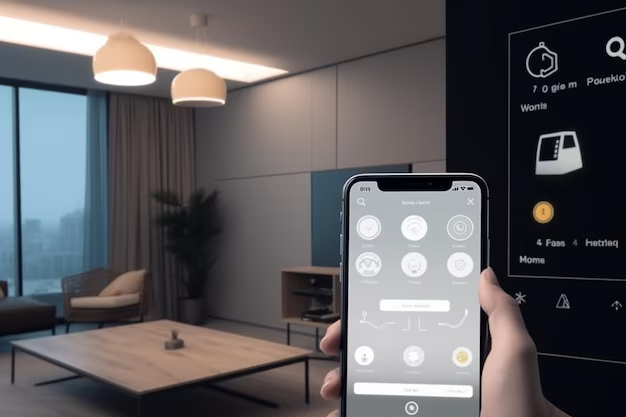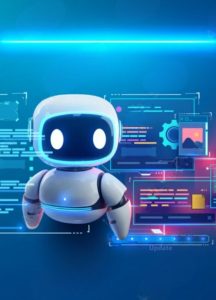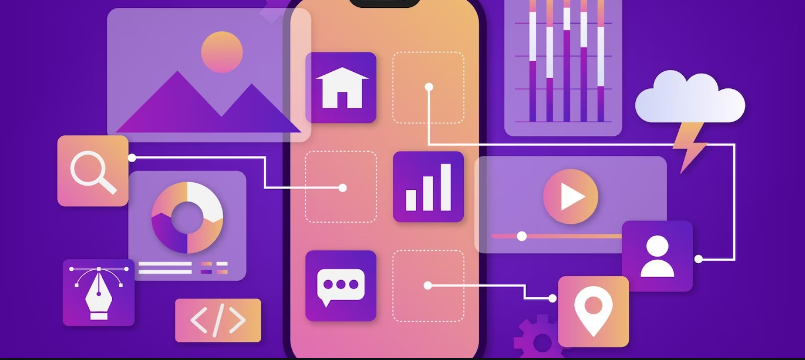The third industrial revolution is not just knocking at our door, it is reshaping our essence as we become more and more dependent on technology, and the realm of Android application development forms the foremost important phase of this transformation. Digital solutions like mobile and software application development can help businesses reach potential customers and enhance operational efficiency. As we move further into 2024, the Android ecosystem undergoes continuous innovation with cutting-edge technologies and trends that are likely to shape the tech-infused future and impact our daily lives.
As we deep dive more into these trends and understand why Android is the go-to platform for a myriad of app developers, let us go through few Android application development statistics as of 2024:
- There are over 3.3 billion active android app users in over 90 countries that is over half the world’s population
- 75% of all smartphones run on Android – the leading mobile operating system with 70.5% market share
- About 1.5 billion Android smartphones were shipped in 2023 suggesting rising demand
- Google Play Store earned $38.6 billion revenue, making it the leading app marketplace
- Around 90K new Android apps are launched and over 10 million mobile app downloads occur every month
- The current global mobile app market revenue is around $430.9 billion
- It is estimated that mobile apps may generate $935 billion in revenue this financial year
- The mobile app market value is estimated to reach $614.40 billion by 2026 at a CAGR of 9.59%
To remain ahead in this competitive domain where business demands evolve quickly, let us explore the comprehensive list of emerging Android app development trends which help in creating engaging applications and expanding digital footprint that meets future demands, to deliver nothing but the best to the customers.

Market size outlook for Android app trends from 2020-2030
Latest Android App Trends
5G Technology
With the emergence of 5G wireless networks, accommodation of next generation mobile apps with the integration of this technology has been widespread and is expected to reach about 5.9 billion subscriptions by 2027. Android apps can leverage unparalleled high density of connections and network capacity, better data speed, less latency for streaming, uploading, downloading high-quality multimedia, 3D features in immersive real-time gaming, receiving updates in autonomous vehicles, responsive cloud-based interactions, smart and remote-controlled devices, seamless navigation, AR/VR implementation etc. This provides an overall enhanced customer experience, intuitive user engagement, higher retention rates and increased revenue for application makers through creative, data-intensive, real-time processing Android apps, thus, reinventing industries.
Touchless & Alternate UI
As per a Gartner report, current Android app trends lean towards reduction of the need to interact face-to-face with Android apps, this has led to 50% of businesses to include touchless experience in their product features as of 2023. These voice user interfaces (VUI) have transformed user experience and turned various processes hands-free, for example, Amazon Echo that works on voice commands, and biometric (facial recognition and retinal scans) screen locks or image capture functions that work on hand gestures instead of tapping, swiping, pinching or pressing, for example, wave of the stylus controls the camera in Samsung Galaxy Note 10, Soli technology in Google Pixel 4 that works on radar-based motion control chip for music, alarms and ringtones, SideChef voice-activated recipe guide and smart cooking devices control app in Samsung Bixby, gaze tracking technology used by Tobii AB in healthcare (disabled people) and edtech tablets, extended reality apps, Facebook, Instagram, Google Calendar as well as Netflix.
This technology is especially useful for the aged and disabled (brain-machine interface for robotic limbs), as it does not require typing or searching for apps, rather a hassle-free, immersive experience through AI assistants that convert spoken language into actionable tasks and work as per spoken instructions. For example, Google Assistant that handles customer queries about 69% of the time, Microsoft Copilot that offers 24/7 instant solutions during business interactions, Siri, Alexa, Facebook Messenger reduces workload agnostically with 300K chatbots powered by Natural Language Processing (NLP). Public touchless screens during the pandemic for booking short distance railway/metro ticket and printing flight boarding passes have proved to be very useful.
Extended Reality
To create application for Android in areas such as corporate and surgical training, education, virtual tourism, gaming, fitness, social media, real estate and architectural walkthroughs, ecommerce etc., Augmented Reality (AR) and Virtual Reality (VR) have become more and more mainstream, rendering a cost-effective solution. These along with Mixed Reality (MR) fall under the umbrella term of Extended Reality (XR), where the AR/VR market is surging at a CAGR of 25.3% to reach a value of $114.5 billion and XR market is to reach a value of $52 billion by 2027. A few examples may include Google’s ARCore platform that provides app developers with more tools, capabilities and Google Maps AR, Pokemon GO AR-based gaming app, SketchAR, IKEA’s virtual product at home visualization app ‘Place’, FaceApp, SnapChat’s Cameo, Virtual Catwalk AR-based clothing app by Asos, Sephora’s virtual makeup app, Zoom’s virtual backgrounds, virtual try on clothes app and more. It especially helps to pioneer innovative solutions in the case of online retail and ecommerce businesses, product churn, return rate is reduced, and client engagement gets fostered by 70%, while driving revenue growth. One counterintelligence challenge faced in Android application development is Deep fakes that spread misinformation, these are up by 1011% in Google searches since 2018.
Another cutting-edge trend that is growing exponentially with a projected market value of $507.8 billion and 2.3 billion by 2030 is Metaverse which uses immersive virtual experiences through AR/VR technologies over social media, such as Decentraland, MOBOX apps, expansive digital universes and 3D environment for social concerts, real estate tours, art galleries, etc. over Facebook, Epic Games etc., thus, changing the way we socialize and conduct businesses.

Market size outlook for Android app trends of Metaverse
Progressive & Super Apps
Progressive web apps form a middle ground between native mobile apps and traditional web apps, by providing a mobile-based app like experience through their respective web browsers. It is not only a cost-effective measure but can be used to reach a broader audience across varied devices and platforms. Super apps, on the other hand, are a one-stop solution with integrated services and products, meeting different requirements of the business, for example, WeChat, Rappi, Tata Neu, Shopify, that serve as multinational commonplaces today by transforming right from digital financial institutions (loans, microinsurance, microfinancing etc.) to markets (food ordering, flight booking etc.).
A sub-domain under super apps are mobile commerce and peer-to-peer (P2P) apps that assist in purchasing products, services flexibly anytime anywhere. Mobile ecommerce revenue is expected to reach a value of $8.1 trillion by 2026, whereas online, mobile banking and file transfer through P2P apps is likely to reach a value of $9.87 trillion in 2030 at a CAGR of 20.16%. Few examples of P2P apps include GooglePay, Apple Pay Cash, PayPal, Zelle, Venmo, Cash App, FrostWire, BitTorrent, μTorrent etc.
Instant & On Demand Apps
Instant apps refer to those Android apps that do not require to be fully installed on the device for users to access their content. This feature is developed for app optimization and smooth performance through instant loading so that users experience remains frictionless, and bounce, uninstallation or abandonment rates reduce drastically. For example, certain applications on Google Play Store that appear with the option of ‘Try Right Now’ without having to download, host the app or consume lot of storage, allowing users to familiarize themselves with the same through a simple, quick and effortless testing over cloud. Although, they form only 0.13% of all Android apps, their downloads is likely to increase up to 3 billion by the end of 2024.
Another area of Android app trends include on demand apps, that are developed for rendering services as a versatile solution for traditional businesses across diverse sectors such as scheduling doctor’s appointment in Practo, booking Uber ride, ordering medicines in Medilife, ordering food in GrubHub, online education, gift ordering, beauty services through TaskRabbit etc. These apps majorly saw the surge in usage and varied functionalities development during the pandemic times. On demand Android apps have seen investments of around $60 billion with 22 million users and their market value is expected to be worth $4,300 million by 2030, as more economies move towards digitization and businesses tend to foster brand awareness to establish their authority niche by bridging the gap for immediate gratification.
Low Code/No Code
Low code/no code app development has seen a dramatic increase amongst companies that seek increase in efficiency and streamlining and managing user processes, as this trend helps them in gaining information at a single click to create application for Android. It provides an effortless, cost-effective and faster program development cycle, as well as is lesser prone to bugs due to lower code volume, thus ensuring higher performance as viewers can receive an accurate view of the user-friendly app as it addresses their needs. For example, it is now feasible to easily change editing apps without having to alter the parent code completely; plug-and-play integrations in Zapier with other services and Android apps, building web apps by non-technical resources through Bubble, Google’s AppSheet, and productivity apps like Airtable and Notion for website development. This trend is breaking the barriers for non-IT businesses to enter this field and bring their app ideas to life by providing drag-and-drop interfaces, pre-built components and visual scripting tools.
AI/ML Technology
Artificial Intelligence (AI) and Machine Learning (ML) are gaining momentum these days for Android app development (Google ML Kit, Apple’s Core ML, ChatGPT), and AI assistants like Apple’s Siri and Amazon’s Alexa, help in establishing that fact, by sharing the weather forecast, or playing the user’s favorite music by a single lined voice command (NLP). The influx of AI/ML into custom application development services can be seen through data mining, adaptive AI and predictive analytics ($28.1 billion by 2026 at a CAGR of 22.17%) like suggested preferences in Netflix, UberEats, Spotify, SnapChat filters, high pattern recognition for traffic by Google Maps, predicting health issues and nutritional plans, equipment (or car) maintenance in industries, financial-related and fraud detection in banking sectors, dynamic pricing in travel offers, customer’s shopping behavior, and others like face recognition using OpenCV, real-time assistance with chatbots, even bug identification with its subsequent root cause analysis, for enhanced privacy in user experience and gaining a competitive edge in the market.

Market size outlook for AI integration as an Android app trend from 2021-2030
Internet of Things (IoT)
Developers are focused on creating seamless experiences for customers with Android apps that interact and monitor surrounding IoT ($483 billion by 2027) ecosystem with smart devices such as fitness trackers, M-commerce wearables (projected market value $392.4 billion by 2030), home automation systems, connected appliances and even smart cities. This ensures efficient data transmission, customized payment notifications, voice memos, colored signals, deep lens camera, room light, thermostat and refrigeration controls, irrigation controls in farming, vehicle tracking in logistics, lighter, faster apps with more functionalities and the symbiosis of a higher layer connection between user with hardware in various industries. Few major players making inroads in IoT apps space include Honeywell, Samsung, Xiaomi, Nest etc.
A prominent Android application development trend that falls under this segment and bridges the gap between offline and online experiences is Beacon (wireless transmitters) technology that uses Bluetooth Low Energy (BLE) gadgets to connect to nearby apps for proximity-based location services and personalized content such as discount alerts at nearby restaurant or retail store, notifications for nearby unauthorized area, events, museums and transportation.

Smart Home Android application development powered by IoT technology
Blockchain Integration & Security
One of the most important Android app trends of 2024 is polarization of app security, privacy and limiting its risk, as security flaws like data breaches are discovered in about 84% of Android apps. This necessity is supported by robust encryption (AES, RSA, ECC, SHA-256, SHA-3, MD5) and compression (LZ77, LZ78, LZMA, BWT, MTF, Bzip2), secure biometric authentication protocol, vulnerability patching, GDPR and CCPA compliance and the stable infrastructure (public, private, consortium architecture like Google Play Protect, Android Jetpack Library, Coinbase) of Blockchain ($39.9 billion by 2025) integration in Android apps, that reduces risk of third-party apps, frauds, bogus information due to its decentralized designs, improves data security, provides transparency and traceability, saves cost and time for developers.
Cloud & Edge Computing
Developing Android apps with cloud computing, such as Google Cloud Platform, Firebase etc., extinguishes the need to purchase, manage and maintain physical servers, data centers, create application for Android which are platform/device agnostic or utilization of phone storage, as users can connect to applications through the internet, access information stored on server, and increase their smartphones’ performance, while ensuring minimal data loss. Contrary to this, with the rise of AI/ML and decentralized data processing (DApps, Ethereum, Web3 apps), edge computing has also become necessary to keep data in place securely, access it more quickly and flexibly, as this will also contribute to growth of IoT devices. Fusion of edge computing and Android app development has led to the development of hyper-responsive apps for autonomous driving and telemedicine. Quantum computing is another area of interest that harnesses quantum mechanics for better computational power and data security, for example, fintech apps and suggesting optimized routes in logistics app (91% of global business leaders are investing in it).
Others
Few other notable Android app trends include customized media, gaming, education, productivity apps like TickTick, Microsoft’s Surface Duo etc. for dual-screen and foldable devices (50 million shipments in 2023, $42 billion market by 2027) like Samsung Galaxy Fold, Motorola RAZR, OPPO Find N2 Flip, Huawei’s Mate X etc. These devices have larger screens, multi-window/app operability, split-screen functionalities, and responsive design where apps seamlessly adapt to layouts, orientations, aspect ratios, screen configurations during folding, flex mode and unfolding of the device. Sustainable, energy-efficient app development is gaining momentum due to the global green revolution focusing on reduced resource consumption and digital platforms with lower carbon footprints.
One can also see an increase in the camera-based mobile development of entertainment (social media, streaming, broadcasting) and gaming ($173.4 billion by 2026) apps like PUBG, Netflix, TikTok with flexible design and better sharing options. In the digital age, children are surrounded by multiple apps and mobile app-based learning apps ($46.88 billion by 2024 end) like ScienceSpot and video conferencing apps became a necessity during the pandemic. There is a surge observed in medical, banking apps, motion design icon development that helps with user engagement, macro interaction, animated scrolling in apps and subscription monetization model.

Customized Android application development for foldable smartphones
How KritiKal Helps to Stay Ahead with Android App Trends
KritiKal Solutions is a leading Android app development company that delivers beyond customer expectations through definitive approaches where user process is kept at the forefront of its systems. Our experts who are skilled in Android Studio, Eclipse, Kotlin, Java, Flutter, AI/ML, IoT, 5G technology etc., have conceptualized, designed and developed solutions like native and progressive web apps, on demand apps, wearable apps etc. for many SMBs, Fortune500 companies and startups working in the entertainment, edtech, finance, retail and other industries. Partner with KritiKal to leverage its 21+ years of experience of building stellar Android apps that align with the latest trends and ensure a transparent process while bringing your app vision to life. Please call us or mail us at sales@kritikalsolutions.com to stay ahead of the curve with our expertise and incorporate these trends into your unique requirements.
Conclusion
The Android application development landscape actively shapes user aspirations, behaviors, and the upcoming trends in 2024 are tilting towards intertwined digital and physical realities. As we saw in this blog that Android apps are likely to remain in power by opening new pathways to personal and business growth, it is fair to conclude by saying that technological advancement and market demands leave a huge impact on industry verticals and are also the main factors that lead to the ever-evolving Android app trends. It is eminent for businesses to pay attention to the growing emphasis on accessibility and inclusivity to a broader audience amongst the surge in demand for staying attuned to trends like foldable devices, IoT, blockchain, touchless UIs, voice commands, etc. ensuring enhanced digital experience and driving meaningful changes in our app-powered daily lives.

Aditya Kumar currently works as a Senior Software Engineer at KritiKal Solutions. He has brought about his expertise in ReactJS, ReactNative, VueJS, NodeJS, MongoDB, NodeJS, CSS etc., alongside a keen eye for industry trends in the ever-evolving tech landscape to help KritiKal execute innovative projects involving web and mobile app development to major some clients.



 Global
Global  United States
United States 
